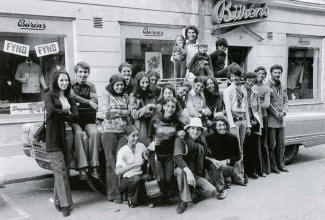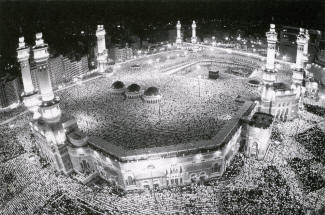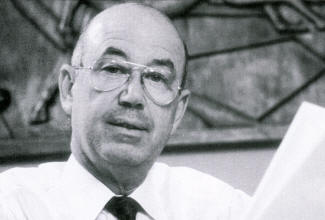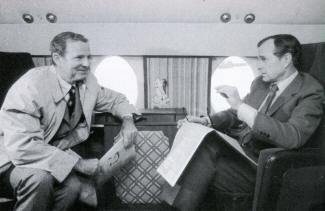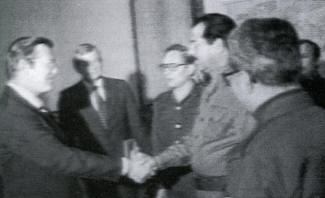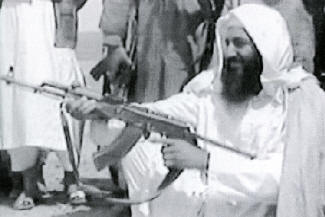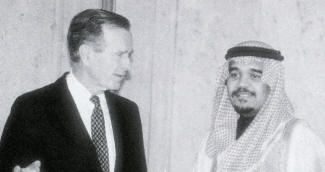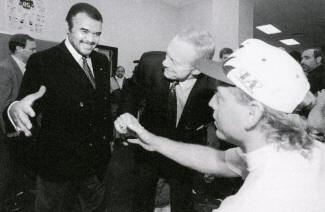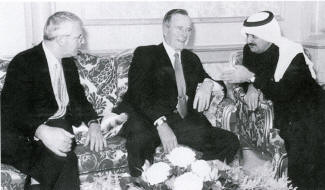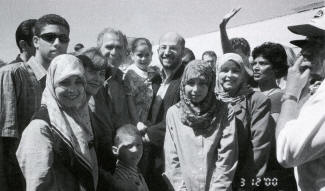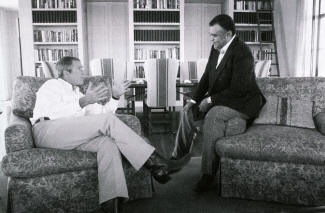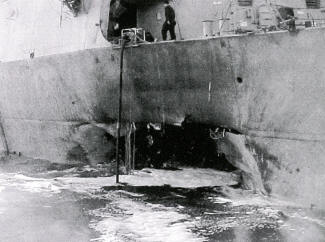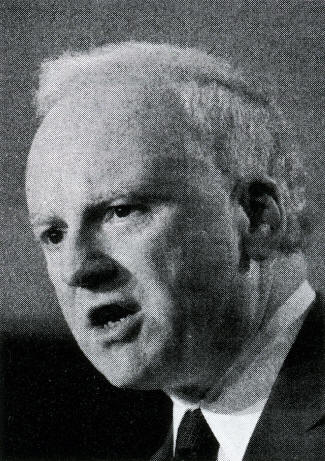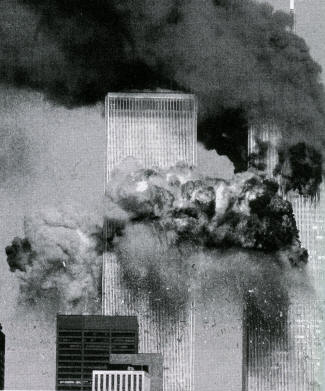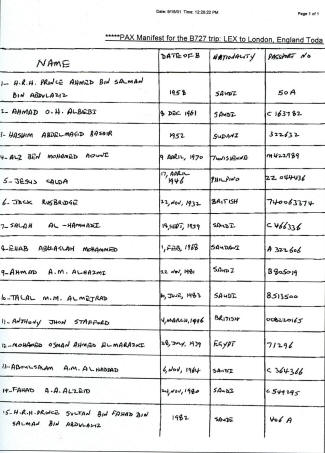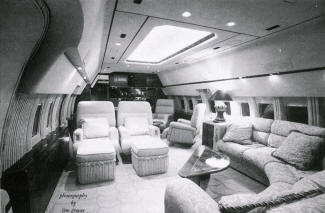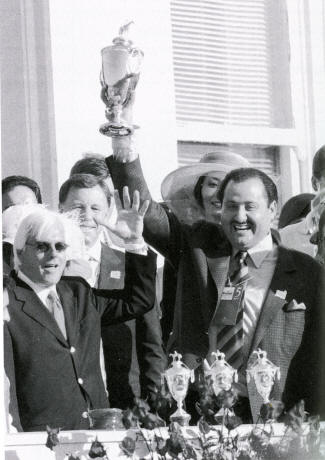Re: House of Bush, House of Saud, by Craig Unger
PART 1 OF 2
CHAPTER FOURTEEN: 9/11
Just before 6 a.m. on September 11, President Bush awoke at the Colony Beach and Tennis Resort, an island enclave in the Gulf of Mexico, near Sarasota, Florida. He put on his running shorts and, accompanied by his Secret Service men, took a four-mile jog. [1]
Meanwhile, in Washington, the top brass of the Carlyle Group and scores of prospective investors began getting ready for an investors' conference at the Ritz Carlton Hotel in Washington. It was their custom to serve coffee and breakfast pastries at about 7:30 and to start the presentations half an hour later. Among those attending were James Baker, Frank Carlucci, and, representing the bin Laden family, Shafig bin Laden, one of Osama's many brothers.
At 7:59 a.m., American Airlines Flight 11 took off from Boston's Logan International Airport en route to Los Angeles. Five Al Qaeda operatives were seated aboard, one of whom, Abdulaziz Alomari, had gained entree to the United States without even having to go to the onsulate himself -- thanks to the Visa Express program recently instituted in Saudi Arabia.
At about the same time, Khalid Almidhar and Nawaf Alhazmi, the two Saudis who indirectly received money from Prince Bandar's wife, Princess Haifa, stood in Washington's Dulles International Airport, getting ready to board American Airlines Flight 77 to Los Angeles scheduled to leave at 8:10. They were accompanied by three compatriots -- Salem Alhazmi, who was possibly Nawaf's brother, Majed Moqed, a twenty-four-year-old operative about whom little is known, and Hani Hanjour, the Saudi who took flying lessons in Phoenix and who, the FBI had noted, was so curious about airplane security. Two of the Saudi operatives on the plane, Khalid Almidhar and Salem Alhazmi, also had entered the United States using the Visa Express program.
At about 8:13, the hijacking of American Airlines Flight 11 began. [i] It soon veered dramatically off course from its scheduled destination, L.A., and went toward New York instead. At 8:46, the plane crashed into the north tower of the World Trade Center.
At that moment, President Bush's motorcade was on its way to the Emma E. Booker elementary school in Sarasota. When he arrived just before 9:00, Karl Rove rushed up to the president, took him aside in a hallway, and told him about the plane crash. "What a horrible accident," Bush replied. According to White House communications director Dan Bartlett, who was also present, Bush, a former pilot, asked if the cause had been bad weather. [2] Accounts differ as to whether Bush was informed about the attack before this or not, but it is clear he had been told about the first crash by nine o'clock. [3]
At about 9:03 Bush entered the second-grade classroom. The occasion was an opportunity to promote his education policies. Altogether, with his staff, members of the media, and the students, there were about 150 people in the room. Bush was introduced to the students and posed for pictures with them. Then the teacher led the students in reading exercises. At this point there was no reason for Bush to think the crash was anything more than a tragic accident.
Just as Bush entered the classroom, however, United Airlines Flight 175, which had also been hijacked after its departure from Boston, crashed into the second World Trade Center tower.
One of the many ironies of the attack was that Marvin Bush, the president's brother, owned stock in and had served as a director of a company, Stratesec, that handled security for three clients that figured prominently in the attack -- United Airlines; Dulles Airport, from which American Airlines Flight 77 was hijacked; and the World Trade Center itself. Conspiracy theorists have tried, with little success, to make something of the connection, even though Marvin Bush left the board of Stratesec prior to 9/11. [ii] Nonetheless, this connection between the House of Bush and the breakdown in airport security, potentially a political embarrassment, never gained prominence in the mainstream press.
At the Ritz Carlton Hotel in Washington, D.C., those attending the Carlyle Group's investment conference were glued to TV monitors showing the attack in progress. According to one source, after the second plane hit, Shafig bin Laden removed his name tag. He and James Baker, the source added, left shortly thereafter in separate cars.
Captain Deborah Loewer, the director of the White House Situation Room, who was traveling with Bush, also saw the second crash on television while she was at the elementary school in Sarasota. "It took me about thirty seconds to realize that this was terrorism," she said. [4]
She immediately told Andrew Card, the White House chief of staff, who whispered to Bush, still in the classroom full of second-graders, "Captain Loewer says it's terrorism."
Then the classroom was silent for about thirty seconds. [5] In the back of the room, press secretary Ari Fleischer held up a pad of paper for Bush to see. "Don't Say Anything Yet" was written on it in big block letters. [6] Bush nodded his assent. Finally, he picked up the book to read a story called "The Pet Goat" with the children. In unison, the children read aloud, "The Pet Goat. A-girl-got-a-pet-goat. But-the-goat-did-some-things-that-made-the-girl's-dad-mad." As the reading continued, Bush said, "Really good readers, whew! ... These must be sixth-graders!" [7]
The reading continued for eight or nine minutes, and at 9:12, Bush left the room. [8]
By this time, the entire world was aware that a truly historic event was taking place. Thousands were dead or dying. Millions of people across the country, especially in New York and Washington, were in a state of panic.
At 9:30, Bush addressed the nation. "Today we had a national tragedy," he said. "Two airplanes have crashed into the World Trade Center in an apparent terrorist attack on our country."
Then he vowed "to hunt down and to find those folks who committed this act. Terrorism against our nation will not stand."
To the overwhelming majority of Americans the attacks had come completely out of the blue. Within the intelligence world, however, many knew who was behind them and Richard Clarke was one of those people. "This is Al Qaeda," he said as soon as a third hijacked jet crashed, this one into the Pentagon. [9]
CIA director George Tenet was eating breakfast with former senator David Boren at the St. Regis Hotel in Washington when he was told about the hijackings. He instantly came to the same assessment. "This has bin Laden's fingerprints all over it," he said. [10] At 10:06, a fourth hijacked plane, United Airlines Flight 93 from Newark, crashed about eighty miles southeast of Pittsburgh, its hijackers apparently having been overpowered by passengers.
It did not take long to confirm that bin Laden was the perpetrator. Almost immediately after the attacks, celebratory phone calls from bin Laden operatives were intercepted by the National Security Agency.
But over the next chaotic few hours, rather than move to strike just Al Qaeda, various high-ranking officials within the Bush administration saw the attack as an opportunity to pursue another agenda. At 2:40 p.m., Donald Rumsfeld ordered the military to begin working on retaliatory plans -- not just to take out Osama bin Laden, but also to go after Iraq's Saddam Hussein.
According to notes taken by a Rumsfeld aide that day and later obtained by CBS News's David Martin, Rumsfeld said he wanted "best info fast, judge whether good enough to hit SH" -- meaning Saddam Hussein -- "at the same time, not only UBL," the initials used to identify Osama bin Laden. "Go massive," the notes quote Rumsfeld as saying, "sweep it all up, things related and not." [11]
In 1998, Rumsfeld had been a signatory to the Project for a New American Century's "Rebuilding America's Defenses" letter, which had called for the removal of Saddam Hussein. Perhaps this was the "new Pearl Harbor" that had to take place if PNAC's policies were to be implemented.
Meanwhile, the president spent the day flying around the country in Air Force One from Florida to Louisiana to Nebraska before returning to Washington. For much of the day, he was protected by U.S. Air Force servicemen in full combat gear. That night, before going to bed, President Bush dictated some observations into his diary. "The Pearl Harbor of the 21st century took place today." [12]
He added that because he was not a military tactician, he would have "to rely on the advice and counsel of Rumsfeld, [General Henry] Shelton [then chairman of the Joint Chiefs of Staff], [General Richard] Myers and Tenet." [13]
Several people were conspicuously absent from the list -- Colin Powell, Condoleezza Rice, Dick Cheney, and others. But chief among them was Richard Clarke. The man who knew more about Osama bin Laden and Al Qaeda than anyone in the country and who had devoted his professional life to defeating them went unmentioned.
***
Prince Bandar did not go to the Saudi embassy in Washington on the day of the disaster, [14] but he was no doubt very busy. The relationship between the House of Bush and the House of Saud that he had so laboriously reassembled just before the attacks was now in tatters. It was as if in one horrifying moment all the extraordinary contradictions in that relationship -- one that married the guardians of Israel with the guardians of Wahhabi Islam, that joined a secular, consumerist democracy with a puritanical theocratic monarchy -- had suddenly been exposed. Thousands of innocent people had been killed in America and most of the killers were Saudi.
In good times, Bandar was known for his ingratiating charm and puckish bonhomie, for his dazzling parties "where there was more chilled vodka in little shot glasses than I've ever seen," as one guest remembered. [15] There was also the Bandar who delighted in weaving a web of intrigue and participating in covert operations. Now came the Bandar who could be a commanding presence in a time of international crisis.
A virtuoso at spinning the media, he quickly conjured up a reality that entirely dissociated his country from bin Laden and the terrorists and reaffirmed Saudi Arabia's solidarity with the United States -- as if the secret brinksmanship of two weeks earlier had never taken place. He swiftly launched an international media campaign with PR giant Burson Marsteller.
He went on every network news show imaginable, repeating the message that the alliance was still strong. Saudi Arabia was America's friend in a hostile Arab world. Saudi Arabia had nothing to do with terrorism. "We in the kingdom, the government and the people of Saudi Arabia, refuse to have any person affiliated with terrorism to be connected to our country," he told a press conference. [16]
In every venue, he told the world that the widespread reports that Osama bin Laden was a Saudi were wrong because "his citizenship was terminated a long time ago because of his terrorist activities." And when he was asked about the financing of terrorism, Bandar told a reporter that charity was required by Islam and that the Saudi government had no evidence that Saudi money was going to Al Qaeda. [17]
Even as Bandar emphasized his friendship with the United States, he had another pressing item on his agenda. For hundreds of wealthy Saudis, it was not unusual to spend most of the summer in the United States. Some stayed over for the racehorse sales in Lexington, Kentucky, in September and then returned home in the fall. But now Arabs were being arrested all over the United States. Hundreds of Saudis in the United States -- members of the royal family and relatives of Osama bin Laden among them -- feared reprisals if they stayed in the country. They needed to leave immediately. King Fahd himself had mandated that everything possible be done to protect them and return them to the kingdom. Fear was not the only motivation. "It's a perception issue for them back home," said a source who participated in the events that followed. "It looks really bad [to Wahhabi clerics] if the royal family is in the lap of luxury in the U.S. during a crisis." It was essential that the Saudis be granted special permission to return even while U.S. airspace was severely restricted.
At the time, in the aftermath of the terrorist attacks, key figures in the Bush administration who could facilitate such an operation were holed up in the Situation Room, a small underground suite with a plush eighteen-by-eighteen-foot conference room in the West Wing of the White House. Live links connected the room's occupants to the FBI, the State Department, and other relevant agencies. Dick Cheney, Condoleezza Rice, and other officials hunkered down and devoured intelligence, hoping to ascertain whether other terrorist attacks were imminent. The most powerful officials in the administration came and went, among them Colin Powell, George Tenet, and Donald Rumsfeld.
Within the cramped confines of that room, Richard Clarke chaired an ongoing crisis group making hundreds of decisions related to the attacks. Sometime shortly after 9/11 -- he doesn't remember exactly when -- Clarke was approached in the Situation Room about quickly repatriating the Saudis.
"Somebody brought to us for approval the decision to let an airplane filled with Saudis, including members of the bin Laden family, leave the country," Clarke says. "My role was to say that it can't happen until the FBI approves it. And so the FBI was asked -- we had a live connection to the FBI -- and we asked the FBI to make sure that they were satisfied that everybody getting on that plane was someone that it was O.K. to leave. And they came back and said yes, it was fine with them. So we said, 'Fine, let it happen.'" [18]
Clarke, who left the government in March 2003 to run a consulting firm in Virginia, adds that he does not recall who initiated the request, but that it was probably either the FBI or the State Department. Both agencies deny playing any role whatsoever in the episode. [iii] "It did not come out of this place," says one source at the State Department. "The likes of Prince Bandar does not need the State Department to get this done."
A White House official says that no such operation took place.
Richard Clarke's approval for evacuating the Saudis had been conditional upon the FBI's vetting them. "I asked [the FBI] to make sure that no one inappropriate was leaving," he says. "I asked them if they had any objection to Saudis leaving the country at a time when aircraft were banned from flying." Clarke adds that he assumed the FBI had vetted the bin Ladens prior to September 11. "I have no idea if they did a good job," he says. "I'm not in any position to second-guess the FBI."
But despite the evidence to the contrary, FBI officials assert that the Bureau had no part in the Saudi evacuation. The Bureau played no role in facilitating these flights, according to Special Agent John Iannarelli, the FBI's spokesman on counterterrorism activities. Bandar, however, went on CNN and said that the FBI played a critical role in the evacuation. [19]
On Thursday, September 13, Bandar had planned to meet Bush at the White House to discuss the Middle East peace process. The meeting went forward as scheduled, but in the aftermath of the attacks, even the urgent demands of the peace process had to take a backseat to the historic catastrophe two days earlier. Until this meeting, Bandar had seen Bush as someone who did not measure up to his father, but on this occasion he seemed to be truly his own man. [20] The two men went out on the Truman Balcony where they lit up cigars and discussed how they might best deal with captured Al Qaeda operatives.
It is not known whether the two men talked about the evacuation at that time. In any case, the operation to begin flying out approximately 140 Saudis had already been initiated by Bandar. According to Nail al-Jubeir, a spokesman for the Saudi embassy, the flights received approval from "the highest level of the U.S. government." [21] Al-Jubeir added that he did not know if there were private conversations in which Prince Bandar and the president discussed letting the bin Ladens and other Saudis begin to travel even while U.S. airspace was shut down. The White House declined to comment on the issue.
Thus, there are many unanswered questions about who authorized the operation. Did the president know? Did the elder George Bush or James Baker intervene? Or did Bandar go through his old friend Colin Powell in the State Department? Both the elder George Bush and James Baker declined requests for interviews for this book.
Nevertheless, a massive and elaborate operation to fly the Saudis out of the United States was already under way. At about 4:30 that afternoon, Dan Grossi and Manuel Perez, the two private detectives in Tampa, had already departed for Lexington, Kentucky, in a Learjet, accompanying three young Saudi men even though private aircraft were still banned from U.S. skies. Sources familiar with the flight said that one of the men was a young Saudi royal. According to the Tampa Tribune, another was the son of a Saudi army commander. [22] The third Saudi passenger has not been identified.
According to Grossi, about one hour and forty-five minutes after takeoff they landed at Blue Grass Airport in Lexington, a frequent destination for Saudi horse-racing enthusiasts, the most famous of whom was Prince Ahmed bin Salman, a nephew of King Fahd. The father of the forty-two-year-old Prince Ahmed, Prince Salman bin Abdul Aziz, was the powerful governor of Riyadh and one of the Sudairi Seven and had worked closely with Osama bin Laden and his Afghan Arabs during the Afghanistan War in the eighties. Ahmed had gone to college at the University of California at Irvine and eventually become chairman of Saudi Arabia's Research and Marketing Group, a publishing company with offices in Saudi Arabia and England. But in Kentucky and the world of horse racing, Ahmed was far better known as the owner of many of the top racehorses in the world. In 1994, he and a college friend launched the Thoroughbred Corporation, which bought and trained famous horses such as Sharp Cat, Lear Fan, Royal Anthem, and the greatest of all, the 2001 Horse of the Year, Point Given, which won two legs of racing's Triple Crown. [23]
Prince Ahmed had come to Lexington for the annual September yearling sales. The sale of young racehorses had been suspended on September 11 but resumed the very next day, during which Ahmed bought two horses. "America is home to me," he said. "I am a businessman. I have nothing to do with the other stuff. I feel as badly as any American and I am extremely astonished by [the terrorism]. We have had terrorism in Saudi Arabia and we know how painful it is." [24] Meanwhile, he made plans to leave the country as quickly as possible. According to the New York Times, sometime after the attacks but before September 14, members of the bin Laden family were driven or flown under FBI supervision first to a secret assembly point in Texas and later to Washington. [25] [iv]
On Friday, September 14, the nation's 200,000 private planes were cleared to fly. The paralyzed air transportation system slowly ramped up again with new security measures instituted all over the country to thwart hijackers. Initially, Bandar's operation had required, and obtained, White House approval. Now such permission was no longer necessary to fly. But the Bush administration had launched a global war against terror. Within days of the attacks, the FBI was circulating a list of more than one hundred suspects to airlines and more than eighteen thousand law-enforcement organizations. FBI director Robert Mueller said the investigation had generated more than thirty-six thousand leads. There were hundreds of search warrants and subpoenas, and seizures of computers and documents. Agents conducted hundreds of interviews around the country. [26] All over the United States, Arabs were being detained. Attorney General John Ashcroft asserted that the government had to take "people into custody who have violated the law and who may pose a threat to America." [27]
The central question now became whether Saudi royals and their friends would get special treatment from the Bush White House when a massive international crackdown was under way. In the context of the global manhunt and war on terror, didn't it make sense to at least interview Osama bin Laden's relatives and other Saudis who, inadvertently or not, may have funded him? Nevertheless, as Bandar's massive operation to get the Saudis out of the United States continued, the FBI repeatedly declined to interrogate or conduct extended interviews with the Saudis.
In addition to the Tampa-Lexington flight, at least seven other planes were made available for the operation. According to itineraries, passenger lists, and interviews with sources who had firsthand knowledge of the flights, members of the extended bin Laden family, the House of Saud, and their associates also assembled in Los Angeles, Las Vegas, Dallas, Houston, Cleveland, Orlando, Washington, D.C, Boston, Newark, and New York.
Arrangements for the flights were made with lightning speed. One flight, a Boeing 727 that left Los Angeles late on the night of September 14 or early in the morning of the fifteenth, required FAA approval, which came through in less than half an hour. "By bureaucratic standards, that's a nanosecond," said a source close to the flight. [28]
Payments for the charter flights were made in advance through wire transfer from the Saudi embassy. A source close to the evacuation said such procedures were an indication that the entire operation had high-level approval from the U.S. government. "That's a totally traceable transaction," he said. "So I inferred that what they were doing had U.S. government approval. Otherwise, they would have done it in cash."
According to the source, a young female member of the bin Laden family was the sole passenger on the first leg of the flight, from Los Angeles to Orlando. In the immediate aftermath of 9/11, boarding any airplane was cause for anxiety. But now that the name Osama bin Laden had become synonymous with mass murder, boarding a plane with his family members was another story entirely. To avoid unnecessary dramas, the flight's operators made certain that the cockpit crew was briefed about who the passengers were -- the bin Ladens -- and the highly sensitive nature of their mission.
However, they neglected to brief the flight attendants.
On the flight from Los Angeles, the bin Laden girl began talking to an attendant about the horrid events of 9/11. "I feel so bad about it," she said.
"Well, it's not your fault," replied the attendant, who had no idea who the passenger really was.
"Yeah," said the passenger. "But he was my brother."
"The flight attendant just lost it," the source said. [29]
***
When the 727 landed in Orlando, Khalil Binladin, whose estate in Winter Garden was nearby, boarded the plane. [30] After a delay of several hours, it continued to Washington.
Meanwhile, in Las Vegas, the Saudis had chartered a customized DC 8 that belonged to the president of Gabon and was equipped with two staterooms (bedrooms) and sixty-seven seats. According to a source who participated in the operation, the Saudis had hoped to leave Las Vegas on September 14, but were not able to get permission for two days. "This was a nightmare," said a source. "The manifest was submitted the day before. It was obvious that someone in Washington had said okay, but the FBI didn't want to say they could go, so it was really tense. In the end, nobody was interrogated." According to the passenger list, among the forty-six passengers were several high-level Saudi royals with diplomatic passports. On Sunday, September 16, the flight finally left for Geneva, Switzerland. The FBI did not even get the manifest until about two hours before departure. Even if it had wanted to interview the passengers -- and the Bureau had shown little inclination to do so -- there would not have been enough time. [31]
At the same time, an even more lavish Boeing 727 was being readied for Prince Ahmed bin Salman and about fourteen other passengers who were assembling in Lexington. If they felt they had to leave the country, at least it could be said that they were leaving in luxury. The plane, which was customized to hold just twenty-six passengers, had a master bedroom suite furnished with a large upholstered double bed, a couch, night stand, and credenza. Its master bathroom had a gold-plated sink, double illuminated mirrors, and a bidet. There were brass, gold, and crystal fixtures. The main lounge had a fifty-two-inch projection TV. The plane boasted a six-place conference room and dining room with a mahogany table that had controls for up and down movement. [32] The plane left Lexington at 4 p.m. on Sunday, September 16, and stopped in Gander, Newfoundland, en route to London.
And so they flew, one by one, mostly to Europe, where some of the passengers later returned home to Saudi Arabia. On September 17, a flight left Dallas for Newark at 10:30 p.m. [33] On September 18 and 19, two flights left Boston, including the 727 that had originated in Los Angeles. According to a person with firsthand knowledge of the flights, there is no question that they took place with the knowledge and approval of the State Department, the FBI, the FAA, and many other government agencies. "When we left Boston every governmental authority that could be there was there," says the source. "There were FBI agents at every departure point. In Boston alone, there was the FBI, the Department of Transportation, the FAA, Customs, the Immigration and Naturalization Service, the Massachusetts state police, the Massachusetts Port Authority, and probably the Bureau of Alcohol, Tobacco, and Firearms. There were more federal law-enforcement officials than passengers by far." [34]
In Boston, airport authorities were horrified that they were being told to let the bin Ladens go. On September 22, a flight went from New York to Paris, and on September 24, another flight from Las Vegas to Paris. According to passenger lists for many but not all of the flights, the vast majority of passengers were Saudis, but there were also passengers from Egypt, England, Ethiopia, Jordan, Lebanon, Morocco, Nigeria, Norway, the Philippines, Sudan, and Syria. "Not many Saudis like to do menial work," said a source, explaining the other nationalities.
Passengers ranged in age from seven years old to sixty-two. [35] The vast majority were adults. There were roughly two dozen bin Ladens.
"Here you have an attack with substantial links to Saudi Arabia," says John L. Martin, who as chief of internal security in the Criminal Division of the Justice Department supervised investigation and prosecution of national security offenses for eighteen years. [36] "You would want to talk to people in the Saudi royal family and the Saudi government; particularly since they have pledged cooperation. And you would want them to voluntarily submit to interviews that would not necessarily be hostile."
Martin further says that he was particularly surprised at the way the Saudis seemed to be making the rules. "It is an absolute rule of law enforcement that the agent or officers conducting the interviews control the interview, and that the persons of interest, suspects, or prospective defendants do not set the ground rules for the interview," he says. [37]
On September 20, while the Saudi evacuation was still quietly under way, President Bush formally declared a global war on terror in a dramatic speech before Congress. Fortress America, supposedly impregnable, was in a state of shock. The grisly totals were always changing, but at the time, the estimated number of the dead, missing, and injured people was more than thirteen thousand. [38] For security reasons, Vice President Cheney did not even attend the president's address in the capital.
America was united behind the president as never before. "Our war on terror ... will not end until every terrorist group of global reach has been found, stopped, and defeated," President Bush vowed. [39]
"We will starve terrorists of funding, turn them one against another, drive them from place to place until there is no refuge or no rest," he added. "And we will pursue nations that provide aid or safe haven to terrorism. Every nation in every region now has a decision to make: Either you're with us, or you are with the terrorists.
"From this day forward, any nation that continues to harbor or support terrorism will be regarded by the United States as a hostile regime." [40]
Four days later, on September 24, President Bush held a press conference with Colin Powell and treasury secretary Paul O'Neill at which he announced the freezing of assets of twenty-seven individuals or entities that may have been funneling money to terrorists. Although the list looked substantial, in fact many of the named targets had been identified by Richard Clarke long before.
Both Bush and Powell made a point of praising the Saudis. "As far as the Saudi Arabians go ... they've been nothing but cooperative," Bush said. "Our dialogue has been one of -- as you would expect friends to be able to discuss issues. And my discussions with the foreign minister, as well as the ambassador, have been very positive." [41]
"That's exactly right, Mr. President," Powell added. "They have not turned down any requests that we have presented to them."
But in fact, the United States was not particularly demanding of Saudi Arabia. Even after the attacks, Visa Express, the program that allowed three of the 9/11 hijackers to enter the United States without even having to stop by the consulate, and which was described by a consular official as "an open-door policy for terrorists," was continued. [42] In the thirty days after 9/11, the U.S. consulate in Jeddah interviewed only 2 out of 104 applicants. No one was rejected. [43]
And when the United States did make demands of them, the Saudis were not particularly helpful. When U.S. troops attacked the Taliban in Afghanistan after 9/11, the Saudis refused to allow the United States to use Saudi territory to stage military operations. All over Europe authorities rounded up suspected terrorists and froze bank accounts -- but Saudi officials did not follow suit. "Saudi Arabia is completely unsupportive as of today," Robert Baer, the former CIA officer and author of Sleeping with the Devil, said a month after 9/11. "The rank-and-file Saudi policeman is sympathetic to bin Laden. They're not telling us who these people were on the planes." [44]
CHAPTER FOURTEEN: 9/11
Just before 6 a.m. on September 11, President Bush awoke at the Colony Beach and Tennis Resort, an island enclave in the Gulf of Mexico, near Sarasota, Florida. He put on his running shorts and, accompanied by his Secret Service men, took a four-mile jog. [1]
Meanwhile, in Washington, the top brass of the Carlyle Group and scores of prospective investors began getting ready for an investors' conference at the Ritz Carlton Hotel in Washington. It was their custom to serve coffee and breakfast pastries at about 7:30 and to start the presentations half an hour later. Among those attending were James Baker, Frank Carlucci, and, representing the bin Laden family, Shafig bin Laden, one of Osama's many brothers.
At 7:59 a.m., American Airlines Flight 11 took off from Boston's Logan International Airport en route to Los Angeles. Five Al Qaeda operatives were seated aboard, one of whom, Abdulaziz Alomari, had gained entree to the United States without even having to go to the onsulate himself -- thanks to the Visa Express program recently instituted in Saudi Arabia.
At about the same time, Khalid Almidhar and Nawaf Alhazmi, the two Saudis who indirectly received money from Prince Bandar's wife, Princess Haifa, stood in Washington's Dulles International Airport, getting ready to board American Airlines Flight 77 to Los Angeles scheduled to leave at 8:10. They were accompanied by three compatriots -- Salem Alhazmi, who was possibly Nawaf's brother, Majed Moqed, a twenty-four-year-old operative about whom little is known, and Hani Hanjour, the Saudi who took flying lessons in Phoenix and who, the FBI had noted, was so curious about airplane security. Two of the Saudi operatives on the plane, Khalid Almidhar and Salem Alhazmi, also had entered the United States using the Visa Express program.
At about 8:13, the hijacking of American Airlines Flight 11 began. [i] It soon veered dramatically off course from its scheduled destination, L.A., and went toward New York instead. At 8:46, the plane crashed into the north tower of the World Trade Center.
The opening section of The 9/11 Commission Report is entitled "Inside the Four Flights." The information contained in this section is based almost entirely on the reported phone calls. But if the reported calls were faked, we have no idea what happened inside these planes. Insofar as the idea that the planes were taken over by hijackers who looked "Middle Eastern," even "Islamic," has been based on the reported calls, this idea is groundless.
-- Was America Attacked by Muslims on 9/11?, by David Ray Griffin
At that moment, President Bush's motorcade was on its way to the Emma E. Booker elementary school in Sarasota. When he arrived just before 9:00, Karl Rove rushed up to the president, took him aside in a hallway, and told him about the plane crash. "What a horrible accident," Bush replied. According to White House communications director Dan Bartlett, who was also present, Bush, a former pilot, asked if the cause had been bad weather. [2] Accounts differ as to whether Bush was informed about the attack before this or not, but it is clear he had been told about the first crash by nine o'clock. [3]
At about 9:03 Bush entered the second-grade classroom. The occasion was an opportunity to promote his education policies. Altogether, with his staff, members of the media, and the students, there were about 150 people in the room. Bush was introduced to the students and posed for pictures with them. Then the teacher led the students in reading exercises. At this point there was no reason for Bush to think the crash was anything more than a tragic accident.
Just as Bush entered the classroom, however, United Airlines Flight 175, which had also been hijacked after its departure from Boston, crashed into the second World Trade Center tower.
One of the many ironies of the attack was that Marvin Bush, the president's brother, owned stock in and had served as a director of a company, Stratesec, that handled security for three clients that figured prominently in the attack -- United Airlines; Dulles Airport, from which American Airlines Flight 77 was hijacked; and the World Trade Center itself. Conspiracy theorists have tried, with little success, to make something of the connection, even though Marvin Bush left the board of Stratesec prior to 9/11. [ii] Nonetheless, this connection between the House of Bush and the breakdown in airport security, potentially a political embarrassment, never gained prominence in the mainstream press.
At the Ritz Carlton Hotel in Washington, D.C., those attending the Carlyle Group's investment conference were glued to TV monitors showing the attack in progress. According to one source, after the second plane hit, Shafig bin Laden removed his name tag. He and James Baker, the source added, left shortly thereafter in separate cars.
Captain Deborah Loewer, the director of the White House Situation Room, who was traveling with Bush, also saw the second crash on television while she was at the elementary school in Sarasota. "It took me about thirty seconds to realize that this was terrorism," she said. [4]
She immediately told Andrew Card, the White House chief of staff, who whispered to Bush, still in the classroom full of second-graders, "Captain Loewer says it's terrorism."
Then the classroom was silent for about thirty seconds. [5] In the back of the room, press secretary Ari Fleischer held up a pad of paper for Bush to see. "Don't Say Anything Yet" was written on it in big block letters. [6] Bush nodded his assent. Finally, he picked up the book to read a story called "The Pet Goat" with the children. In unison, the children read aloud, "The Pet Goat. A-girl-got-a-pet-goat. But-the-goat-did-some-things-that-made-the-girl's-dad-mad." As the reading continued, Bush said, "Really good readers, whew! ... These must be sixth-graders!" [7]
The reading continued for eight or nine minutes, and at 9:12, Bush left the room. [8]
By this time, the entire world was aware that a truly historic event was taking place. Thousands were dead or dying. Millions of people across the country, especially in New York and Washington, were in a state of panic.
At 9:30, Bush addressed the nation. "Today we had a national tragedy," he said. "Two airplanes have crashed into the World Trade Center in an apparent terrorist attack on our country."
Then he vowed "to hunt down and to find those folks who committed this act. Terrorism against our nation will not stand."
To the overwhelming majority of Americans the attacks had come completely out of the blue. Within the intelligence world, however, many knew who was behind them and Richard Clarke was one of those people. "This is Al Qaeda," he said as soon as a third hijacked jet crashed, this one into the Pentagon. [9]
CIA director George Tenet was eating breakfast with former senator David Boren at the St. Regis Hotel in Washington when he was told about the hijackings. He instantly came to the same assessment. "This has bin Laden's fingerprints all over it," he said. [10] At 10:06, a fourth hijacked plane, United Airlines Flight 93 from Newark, crashed about eighty miles southeast of Pittsburgh, its hijackers apparently having been overpowered by passengers.
It did not take long to confirm that bin Laden was the perpetrator. Almost immediately after the attacks, celebratory phone calls from bin Laden operatives were intercepted by the National Security Agency.
But over the next chaotic few hours, rather than move to strike just Al Qaeda, various high-ranking officials within the Bush administration saw the attack as an opportunity to pursue another agenda. At 2:40 p.m., Donald Rumsfeld ordered the military to begin working on retaliatory plans -- not just to take out Osama bin Laden, but also to go after Iraq's Saddam Hussein.
According to notes taken by a Rumsfeld aide that day and later obtained by CBS News's David Martin, Rumsfeld said he wanted "best info fast, judge whether good enough to hit SH" -- meaning Saddam Hussein -- "at the same time, not only UBL," the initials used to identify Osama bin Laden. "Go massive," the notes quote Rumsfeld as saying, "sweep it all up, things related and not." [11]
In 1998, Rumsfeld had been a signatory to the Project for a New American Century's "Rebuilding America's Defenses" letter, which had called for the removal of Saddam Hussein. Perhaps this was the "new Pearl Harbor" that had to take place if PNAC's policies were to be implemented.
Meanwhile, the president spent the day flying around the country in Air Force One from Florida to Louisiana to Nebraska before returning to Washington. For much of the day, he was protected by U.S. Air Force servicemen in full combat gear. That night, before going to bed, President Bush dictated some observations into his diary. "The Pearl Harbor of the 21st century took place today." [12]
He added that because he was not a military tactician, he would have "to rely on the advice and counsel of Rumsfeld, [General Henry] Shelton [then chairman of the Joint Chiefs of Staff], [General Richard] Myers and Tenet." [13]
Several people were conspicuously absent from the list -- Colin Powell, Condoleezza Rice, Dick Cheney, and others. But chief among them was Richard Clarke. The man who knew more about Osama bin Laden and Al Qaeda than anyone in the country and who had devoted his professional life to defeating them went unmentioned.
***
Prince Bandar did not go to the Saudi embassy in Washington on the day of the disaster, [14] but he was no doubt very busy. The relationship between the House of Bush and the House of Saud that he had so laboriously reassembled just before the attacks was now in tatters. It was as if in one horrifying moment all the extraordinary contradictions in that relationship -- one that married the guardians of Israel with the guardians of Wahhabi Islam, that joined a secular, consumerist democracy with a puritanical theocratic monarchy -- had suddenly been exposed. Thousands of innocent people had been killed in America and most of the killers were Saudi.
In good times, Bandar was known for his ingratiating charm and puckish bonhomie, for his dazzling parties "where there was more chilled vodka in little shot glasses than I've ever seen," as one guest remembered. [15] There was also the Bandar who delighted in weaving a web of intrigue and participating in covert operations. Now came the Bandar who could be a commanding presence in a time of international crisis.
A virtuoso at spinning the media, he quickly conjured up a reality that entirely dissociated his country from bin Laden and the terrorists and reaffirmed Saudi Arabia's solidarity with the United States -- as if the secret brinksmanship of two weeks earlier had never taken place. He swiftly launched an international media campaign with PR giant Burson Marsteller.
He went on every network news show imaginable, repeating the message that the alliance was still strong. Saudi Arabia was America's friend in a hostile Arab world. Saudi Arabia had nothing to do with terrorism. "We in the kingdom, the government and the people of Saudi Arabia, refuse to have any person affiliated with terrorism to be connected to our country," he told a press conference. [16]
In every venue, he told the world that the widespread reports that Osama bin Laden was a Saudi were wrong because "his citizenship was terminated a long time ago because of his terrorist activities." And when he was asked about the financing of terrorism, Bandar told a reporter that charity was required by Islam and that the Saudi government had no evidence that Saudi money was going to Al Qaeda. [17]
Even as Bandar emphasized his friendship with the United States, he had another pressing item on his agenda. For hundreds of wealthy Saudis, it was not unusual to spend most of the summer in the United States. Some stayed over for the racehorse sales in Lexington, Kentucky, in September and then returned home in the fall. But now Arabs were being arrested all over the United States. Hundreds of Saudis in the United States -- members of the royal family and relatives of Osama bin Laden among them -- feared reprisals if they stayed in the country. They needed to leave immediately. King Fahd himself had mandated that everything possible be done to protect them and return them to the kingdom. Fear was not the only motivation. "It's a perception issue for them back home," said a source who participated in the events that followed. "It looks really bad [to Wahhabi clerics] if the royal family is in the lap of luxury in the U.S. during a crisis." It was essential that the Saudis be granted special permission to return even while U.S. airspace was severely restricted.
At the time, in the aftermath of the terrorist attacks, key figures in the Bush administration who could facilitate such an operation were holed up in the Situation Room, a small underground suite with a plush eighteen-by-eighteen-foot conference room in the West Wing of the White House. Live links connected the room's occupants to the FBI, the State Department, and other relevant agencies. Dick Cheney, Condoleezza Rice, and other officials hunkered down and devoured intelligence, hoping to ascertain whether other terrorist attacks were imminent. The most powerful officials in the administration came and went, among them Colin Powell, George Tenet, and Donald Rumsfeld.
Within the cramped confines of that room, Richard Clarke chaired an ongoing crisis group making hundreds of decisions related to the attacks. Sometime shortly after 9/11 -- he doesn't remember exactly when -- Clarke was approached in the Situation Room about quickly repatriating the Saudis.
"Somebody brought to us for approval the decision to let an airplane filled with Saudis, including members of the bin Laden family, leave the country," Clarke says. "My role was to say that it can't happen until the FBI approves it. And so the FBI was asked -- we had a live connection to the FBI -- and we asked the FBI to make sure that they were satisfied that everybody getting on that plane was someone that it was O.K. to leave. And they came back and said yes, it was fine with them. So we said, 'Fine, let it happen.'" [18]
Clarke, who left the government in March 2003 to run a consulting firm in Virginia, adds that he does not recall who initiated the request, but that it was probably either the FBI or the State Department. Both agencies deny playing any role whatsoever in the episode. [iii] "It did not come out of this place," says one source at the State Department. "The likes of Prince Bandar does not need the State Department to get this done."
A White House official says that no such operation took place.
Richard Clarke's approval for evacuating the Saudis had been conditional upon the FBI's vetting them. "I asked [the FBI] to make sure that no one inappropriate was leaving," he says. "I asked them if they had any objection to Saudis leaving the country at a time when aircraft were banned from flying." Clarke adds that he assumed the FBI had vetted the bin Ladens prior to September 11. "I have no idea if they did a good job," he says. "I'm not in any position to second-guess the FBI."
But despite the evidence to the contrary, FBI officials assert that the Bureau had no part in the Saudi evacuation. The Bureau played no role in facilitating these flights, according to Special Agent John Iannarelli, the FBI's spokesman on counterterrorism activities. Bandar, however, went on CNN and said that the FBI played a critical role in the evacuation. [19]
On Thursday, September 13, Bandar had planned to meet Bush at the White House to discuss the Middle East peace process. The meeting went forward as scheduled, but in the aftermath of the attacks, even the urgent demands of the peace process had to take a backseat to the historic catastrophe two days earlier. Until this meeting, Bandar had seen Bush as someone who did not measure up to his father, but on this occasion he seemed to be truly his own man. [20] The two men went out on the Truman Balcony where they lit up cigars and discussed how they might best deal with captured Al Qaeda operatives.
It is not known whether the two men talked about the evacuation at that time. In any case, the operation to begin flying out approximately 140 Saudis had already been initiated by Bandar. According to Nail al-Jubeir, a spokesman for the Saudi embassy, the flights received approval from "the highest level of the U.S. government." [21] Al-Jubeir added that he did not know if there were private conversations in which Prince Bandar and the president discussed letting the bin Ladens and other Saudis begin to travel even while U.S. airspace was shut down. The White House declined to comment on the issue.
Thus, there are many unanswered questions about who authorized the operation. Did the president know? Did the elder George Bush or James Baker intervene? Or did Bandar go through his old friend Colin Powell in the State Department? Both the elder George Bush and James Baker declined requests for interviews for this book.
Nevertheless, a massive and elaborate operation to fly the Saudis out of the United States was already under way. At about 4:30 that afternoon, Dan Grossi and Manuel Perez, the two private detectives in Tampa, had already departed for Lexington, Kentucky, in a Learjet, accompanying three young Saudi men even though private aircraft were still banned from U.S. skies. Sources familiar with the flight said that one of the men was a young Saudi royal. According to the Tampa Tribune, another was the son of a Saudi army commander. [22] The third Saudi passenger has not been identified.
According to Grossi, about one hour and forty-five minutes after takeoff they landed at Blue Grass Airport in Lexington, a frequent destination for Saudi horse-racing enthusiasts, the most famous of whom was Prince Ahmed bin Salman, a nephew of King Fahd. The father of the forty-two-year-old Prince Ahmed, Prince Salman bin Abdul Aziz, was the powerful governor of Riyadh and one of the Sudairi Seven and had worked closely with Osama bin Laden and his Afghan Arabs during the Afghanistan War in the eighties. Ahmed had gone to college at the University of California at Irvine and eventually become chairman of Saudi Arabia's Research and Marketing Group, a publishing company with offices in Saudi Arabia and England. But in Kentucky and the world of horse racing, Ahmed was far better known as the owner of many of the top racehorses in the world. In 1994, he and a college friend launched the Thoroughbred Corporation, which bought and trained famous horses such as Sharp Cat, Lear Fan, Royal Anthem, and the greatest of all, the 2001 Horse of the Year, Point Given, which won two legs of racing's Triple Crown. [23]
Prince Ahmed had come to Lexington for the annual September yearling sales. The sale of young racehorses had been suspended on September 11 but resumed the very next day, during which Ahmed bought two horses. "America is home to me," he said. "I am a businessman. I have nothing to do with the other stuff. I feel as badly as any American and I am extremely astonished by [the terrorism]. We have had terrorism in Saudi Arabia and we know how painful it is." [24] Meanwhile, he made plans to leave the country as quickly as possible. According to the New York Times, sometime after the attacks but before September 14, members of the bin Laden family were driven or flown under FBI supervision first to a secret assembly point in Texas and later to Washington. [25] [iv]
On Friday, September 14, the nation's 200,000 private planes were cleared to fly. The paralyzed air transportation system slowly ramped up again with new security measures instituted all over the country to thwart hijackers. Initially, Bandar's operation had required, and obtained, White House approval. Now such permission was no longer necessary to fly. But the Bush administration had launched a global war against terror. Within days of the attacks, the FBI was circulating a list of more than one hundred suspects to airlines and more than eighteen thousand law-enforcement organizations. FBI director Robert Mueller said the investigation had generated more than thirty-six thousand leads. There were hundreds of search warrants and subpoenas, and seizures of computers and documents. Agents conducted hundreds of interviews around the country. [26] All over the United States, Arabs were being detained. Attorney General John Ashcroft asserted that the government had to take "people into custody who have violated the law and who may pose a threat to America." [27]
The central question now became whether Saudi royals and their friends would get special treatment from the Bush White House when a massive international crackdown was under way. In the context of the global manhunt and war on terror, didn't it make sense to at least interview Osama bin Laden's relatives and other Saudis who, inadvertently or not, may have funded him? Nevertheless, as Bandar's massive operation to get the Saudis out of the United States continued, the FBI repeatedly declined to interrogate or conduct extended interviews with the Saudis.
In addition to the Tampa-Lexington flight, at least seven other planes were made available for the operation. According to itineraries, passenger lists, and interviews with sources who had firsthand knowledge of the flights, members of the extended bin Laden family, the House of Saud, and their associates also assembled in Los Angeles, Las Vegas, Dallas, Houston, Cleveland, Orlando, Washington, D.C, Boston, Newark, and New York.
Arrangements for the flights were made with lightning speed. One flight, a Boeing 727 that left Los Angeles late on the night of September 14 or early in the morning of the fifteenth, required FAA approval, which came through in less than half an hour. "By bureaucratic standards, that's a nanosecond," said a source close to the flight. [28]
Payments for the charter flights were made in advance through wire transfer from the Saudi embassy. A source close to the evacuation said such procedures were an indication that the entire operation had high-level approval from the U.S. government. "That's a totally traceable transaction," he said. "So I inferred that what they were doing had U.S. government approval. Otherwise, they would have done it in cash."
According to the source, a young female member of the bin Laden family was the sole passenger on the first leg of the flight, from Los Angeles to Orlando. In the immediate aftermath of 9/11, boarding any airplane was cause for anxiety. But now that the name Osama bin Laden had become synonymous with mass murder, boarding a plane with his family members was another story entirely. To avoid unnecessary dramas, the flight's operators made certain that the cockpit crew was briefed about who the passengers were -- the bin Ladens -- and the highly sensitive nature of their mission.
However, they neglected to brief the flight attendants.
On the flight from Los Angeles, the bin Laden girl began talking to an attendant about the horrid events of 9/11. "I feel so bad about it," she said.
"Well, it's not your fault," replied the attendant, who had no idea who the passenger really was.
"Yeah," said the passenger. "But he was my brother."
"The flight attendant just lost it," the source said. [29]
***
When the 727 landed in Orlando, Khalil Binladin, whose estate in Winter Garden was nearby, boarded the plane. [30] After a delay of several hours, it continued to Washington.
Meanwhile, in Las Vegas, the Saudis had chartered a customized DC 8 that belonged to the president of Gabon and was equipped with two staterooms (bedrooms) and sixty-seven seats. According to a source who participated in the operation, the Saudis had hoped to leave Las Vegas on September 14, but were not able to get permission for two days. "This was a nightmare," said a source. "The manifest was submitted the day before. It was obvious that someone in Washington had said okay, but the FBI didn't want to say they could go, so it was really tense. In the end, nobody was interrogated." According to the passenger list, among the forty-six passengers were several high-level Saudi royals with diplomatic passports. On Sunday, September 16, the flight finally left for Geneva, Switzerland. The FBI did not even get the manifest until about two hours before departure. Even if it had wanted to interview the passengers -- and the Bureau had shown little inclination to do so -- there would not have been enough time. [31]
At the same time, an even more lavish Boeing 727 was being readied for Prince Ahmed bin Salman and about fourteen other passengers who were assembling in Lexington. If they felt they had to leave the country, at least it could be said that they were leaving in luxury. The plane, which was customized to hold just twenty-six passengers, had a master bedroom suite furnished with a large upholstered double bed, a couch, night stand, and credenza. Its master bathroom had a gold-plated sink, double illuminated mirrors, and a bidet. There were brass, gold, and crystal fixtures. The main lounge had a fifty-two-inch projection TV. The plane boasted a six-place conference room and dining room with a mahogany table that had controls for up and down movement. [32] The plane left Lexington at 4 p.m. on Sunday, September 16, and stopped in Gander, Newfoundland, en route to London.
And so they flew, one by one, mostly to Europe, where some of the passengers later returned home to Saudi Arabia. On September 17, a flight left Dallas for Newark at 10:30 p.m. [33] On September 18 and 19, two flights left Boston, including the 727 that had originated in Los Angeles. According to a person with firsthand knowledge of the flights, there is no question that they took place with the knowledge and approval of the State Department, the FBI, the FAA, and many other government agencies. "When we left Boston every governmental authority that could be there was there," says the source. "There were FBI agents at every departure point. In Boston alone, there was the FBI, the Department of Transportation, the FAA, Customs, the Immigration and Naturalization Service, the Massachusetts state police, the Massachusetts Port Authority, and probably the Bureau of Alcohol, Tobacco, and Firearms. There were more federal law-enforcement officials than passengers by far." [34]
In Boston, airport authorities were horrified that they were being told to let the bin Ladens go. On September 22, a flight went from New York to Paris, and on September 24, another flight from Las Vegas to Paris. According to passenger lists for many but not all of the flights, the vast majority of passengers were Saudis, but there were also passengers from Egypt, England, Ethiopia, Jordan, Lebanon, Morocco, Nigeria, Norway, the Philippines, Sudan, and Syria. "Not many Saudis like to do menial work," said a source, explaining the other nationalities.
Passengers ranged in age from seven years old to sixty-two. [35] The vast majority were adults. There were roughly two dozen bin Ladens.
"Here you have an attack with substantial links to Saudi Arabia," says John L. Martin, who as chief of internal security in the Criminal Division of the Justice Department supervised investigation and prosecution of national security offenses for eighteen years. [36] "You would want to talk to people in the Saudi royal family and the Saudi government; particularly since they have pledged cooperation. And you would want them to voluntarily submit to interviews that would not necessarily be hostile."
Martin further says that he was particularly surprised at the way the Saudis seemed to be making the rules. "It is an absolute rule of law enforcement that the agent or officers conducting the interviews control the interview, and that the persons of interest, suspects, or prospective defendants do not set the ground rules for the interview," he says. [37]
On September 20, while the Saudi evacuation was still quietly under way, President Bush formally declared a global war on terror in a dramatic speech before Congress. Fortress America, supposedly impregnable, was in a state of shock. The grisly totals were always changing, but at the time, the estimated number of the dead, missing, and injured people was more than thirteen thousand. [38] For security reasons, Vice President Cheney did not even attend the president's address in the capital.
America was united behind the president as never before. "Our war on terror ... will not end until every terrorist group of global reach has been found, stopped, and defeated," President Bush vowed. [39]
"We will starve terrorists of funding, turn them one against another, drive them from place to place until there is no refuge or no rest," he added. "And we will pursue nations that provide aid or safe haven to terrorism. Every nation in every region now has a decision to make: Either you're with us, or you are with the terrorists.
"From this day forward, any nation that continues to harbor or support terrorism will be regarded by the United States as a hostile regime." [40]
Four days later, on September 24, President Bush held a press conference with Colin Powell and treasury secretary Paul O'Neill at which he announced the freezing of assets of twenty-seven individuals or entities that may have been funneling money to terrorists. Although the list looked substantial, in fact many of the named targets had been identified by Richard Clarke long before.
Both Bush and Powell made a point of praising the Saudis. "As far as the Saudi Arabians go ... they've been nothing but cooperative," Bush said. "Our dialogue has been one of -- as you would expect friends to be able to discuss issues. And my discussions with the foreign minister, as well as the ambassador, have been very positive." [41]
"That's exactly right, Mr. President," Powell added. "They have not turned down any requests that we have presented to them."
But in fact, the United States was not particularly demanding of Saudi Arabia. Even after the attacks, Visa Express, the program that allowed three of the 9/11 hijackers to enter the United States without even having to stop by the consulate, and which was described by a consular official as "an open-door policy for terrorists," was continued. [42] In the thirty days after 9/11, the U.S. consulate in Jeddah interviewed only 2 out of 104 applicants. No one was rejected. [43]
And when the United States did make demands of them, the Saudis were not particularly helpful. When U.S. troops attacked the Taliban in Afghanistan after 9/11, the Saudis refused to allow the United States to use Saudi territory to stage military operations. All over Europe authorities rounded up suspected terrorists and froze bank accounts -- but Saudi officials did not follow suit. "Saudi Arabia is completely unsupportive as of today," Robert Baer, the former CIA officer and author of Sleeping with the Devil, said a month after 9/11. "The rank-and-file Saudi policeman is sympathetic to bin Laden. They're not telling us who these people were on the planes." [44]
